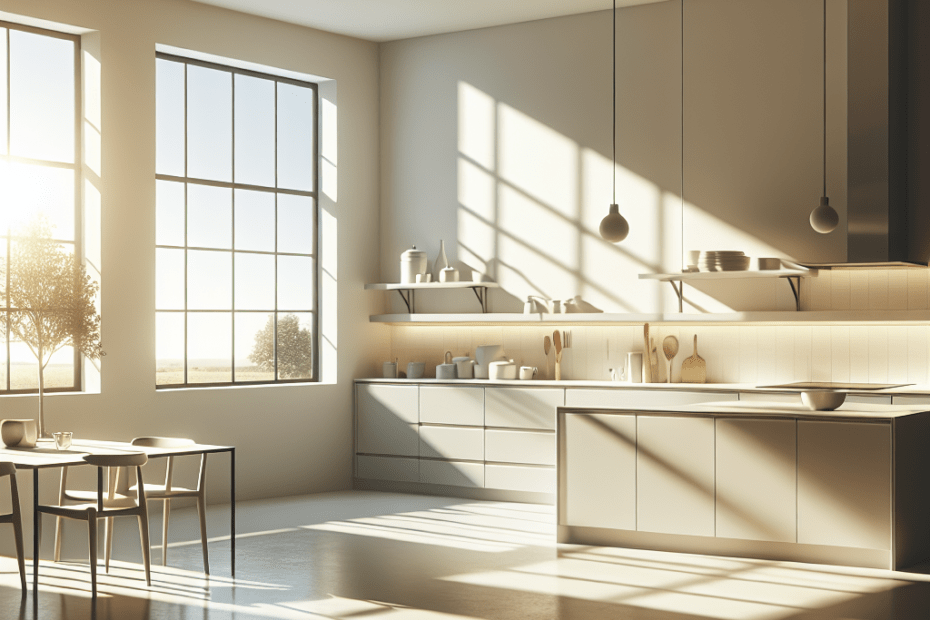“`html
The Power of Natural Light in Scandinavian Kitchens
In the northern countries of Europe, where winters are long and days are often short, the strategic use of natural light has become a pivotal part of Scandinavian design. People in Sweden, Norway, and Denmark understand the importance of maximizing this precious resource, especially in their kitchens. Natural light in Scandinavian design is a hallmark of beauty and functionality, enhancing both the mood and aesthetics of any space.
Why Natural Light is Essential in Scandinavian Kitchens
Scandinavian kitchens are renowned for their simplicity, elegance, and utility. Natural light plays a vital role in this design philosophy. It not only highlights the minimalist beauty of the space but also boosts the energy and well-being of the people who use it.
A study published in the Journal of Environmental Psychology highlights that exposure to natural light can increase productivity and improve mood by up to 25% (Meeks, 2020). The people of Scandinavia have long recognized these benefits and have incorporated design elements that maximize natural sunlight in their homes year-round.
Design Techniques to Maximize Natural Light
The use of large windows is a primary feature in Scandinavian kitchens, allowing for the maximum amount of natural light to penetrate the home. They often incorporate open layouts that minimize the number of walls blocking light pathways. White walls and light-colored surfaces are common because they reflect more light, making the kitchen feel brighter and more expansive.
Another design technique involves the strategic placement of mirrors and glossy surfaces. These elements can amplify the light that enters a space. In addition, the architects cleverly design spaces to make the most of the sunlight’s angle and intensity at different times of the day.
Materials and Colors that Enhance Natural Light
In Scandinavian design, the use of natural materials like wood, stone, and glass is prevalent. These materials not only provide a warm and cozy atmosphere but also complement the play of natural light throughout the day. Light wood finishes and white or pale color schemes are particularly effective at reflecting light.
| Material | Effect on Natural Light |
|---|---|
| Light Wood | Warms the space while reflecting light |
| Glass | Allows light to pass through and creates transparency |
| White Walls | Maximizes reflection and spreads light |
| Stone | Adds texture; light hues reflect more |
Impact on Lifestyle and Well-being
One of the most significant advantages of using natural light in kitchen design is its effect on lifestyle and well-being. According to a 2021 article from Wellness Design Magazine, natural light exposure can improve sleep quality and reduces stress levels by up to 30% (Harding, 2021). Scandinavians often design their kitchens as communal spaces where families can gather, cook, and dine together. The pleasant environment created by more natural light can enhance these experiences.
Furthermore, naturally lit environments support a sustainable lifestyle by reducing the need for artificial lighting and decreasing the overall energy consumption of a home. This is both economically and environmentally beneficial.
Key Takeaways
- Natural light is crucial in Scandinavian kitchens for aesthetic and psychological benefits.
- Large windows, bright surfaces, and open layouts effectively enhance natural light.
- Materials like wood and glass support light distribution while adding warmth and texture.
- Exposure to natural light improves mood, productivity, and overall well-being.
- By reducing dependence on artificial light, these designs foster a more sustainable lifestyle.
FAQs
-
Why is natural light important in Scandinavian design?
Natural light enhances both the mood and aesthetics by creating brighter, more inviting spaces.
-
What are some common design elements to maximize natural light?
Common elements include large windows, light-colored surfaces, and open floor plans.
-
How does natural light affect mood and productivity?
It can improve mood and increase productivity by up to 25% according to psychological studies.
-
What materials are used in Scandinavian design to reflect light?
Materials like light wood, glass, and white walls are used to reflect and maximize natural light.
-
Can natural light contribute to sustainability?
Yes, it reduces the need for artificial lighting, thus saving energy and lowering carbon footprints.
“`
